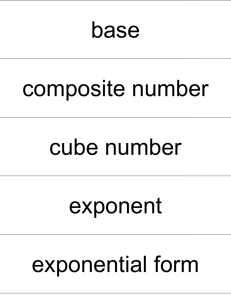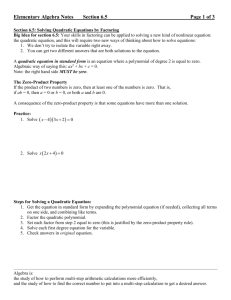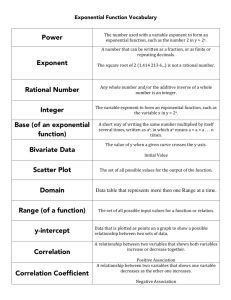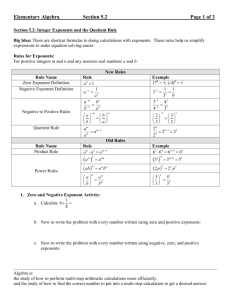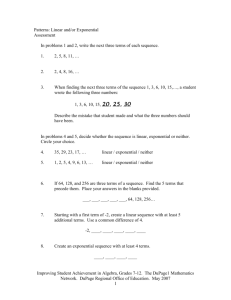Lecture notes for Section 9.2
advertisement
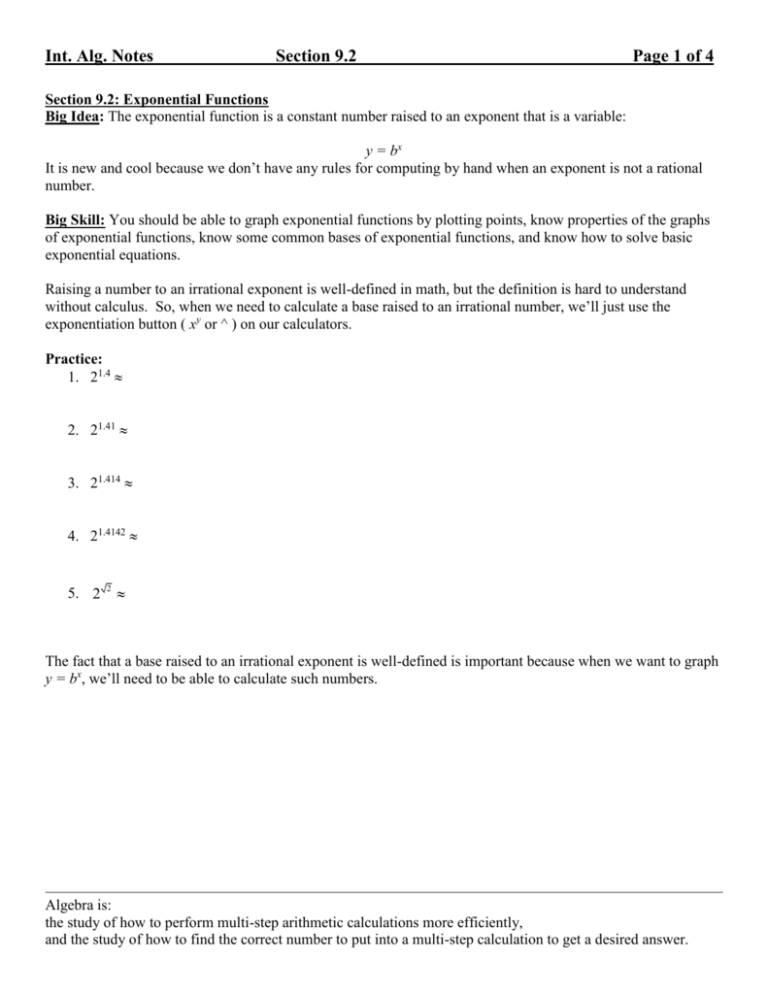
Int. Alg. Notes Section 9.2 Page 1 of 4 Section 9.2: Exponential Functions Big Idea: The exponential function is a constant number raised to an exponent that is a variable: y = bx It is new and cool because we don’t have any rules for computing by hand when an exponent is not a rational number. Big Skill: You should be able to graph exponential functions by plotting points, know properties of the graphs of exponential functions, know some common bases of exponential functions, and know how to solve basic exponential equations. Raising a number to an irrational exponent is well-defined in math, but the definition is hard to understand without calculus. So, when we need to calculate a base raised to an irrational number, we’ll just use the exponentiation button ( xy or ^ ) on our calculators. Practice: 1. 21.4 2. 21.41 3. 21.414 4. 21.4142 5. 2 2 The fact that a base raised to an irrational exponent is well-defined is important because when we want to graph y = bx, we’ll need to be able to calculate such numbers. Algebra is: the study of how to perform multi-step arithmetic calculations more efficiently, and the study of how to find the correct number to put into a multi-step calculation to get a desired answer. Int. Alg. Notes Section 9.2 Page 2 of 4 Practice: 1. Graph y = 2x. 2. Graph y = (1/2)x. 3. Graph y = 10x. 4. Graph y = 10-x. Algebra is: the study of how to perform multi-step arithmetic calculations more efficiently, and the study of how to find the correct number to put into a multi-step calculation to get a desired answer. Int. Alg. Notes Section 9.2 Page 3 of 4 Facts about the exponential function: 1. The constant number b is called the base. 2. The base must be greater than zero (b > 0). 3. Some common bases are 2, 10, and e. 4. The base can’t be equal to one (b 1). 5. The variable x, which is the exponent, can be any real number (i.e., the domain of the function is all real numbers). 6. The dependent variable y will take on all values greater than zero (i.e., the range is y > 0). 7. The graph always passes through the point (0, 1), because any number raised to the power of zero equals one. 8. The graph also always contains the points (1, b) and (-1, 1/b). 9. The graph of the function increases if b > 1, while the graph decreases if 0 < b < 1, as shown below: This is for b > 1 This is for 0 < b < 1 Definition of e: n 1 The number e is defined as the number that the expression 1 approaches as n gets bigger without bound. n Algebra is: the study of how to perform multi-step arithmetic calculations more efficiently, and the study of how to find the correct number to put into a multi-step calculation to get a desired answer. Int. Alg. Notes Section 9.2 Page 4 of 4 Solving exponential equations: If au = av, then u = v. Practice: 1. 3x 27 2. 2 x3 16 2 3x 27 3. 9 2 e2 x e2 4. 3x e Compound Interest Formula: The amount A in a bank account for a principal P compounded at an annual interest rate r n times per year for t r years is: A P 1 n nt Algebra is: the study of how to perform multi-step arithmetic calculations more efficiently, and the study of how to find the correct number to put into a multi-step calculation to get a desired answer.

